CHEVROLET CORVETTE 1994 4.G Service Manual
Manufacturer: CHEVROLET, Model Year: 1994, Model line: CORVETTE, Model: CHEVROLET CORVETTE 1994 4.GPages: 274, PDF Size: 15.61 MB
Page 41 of 274
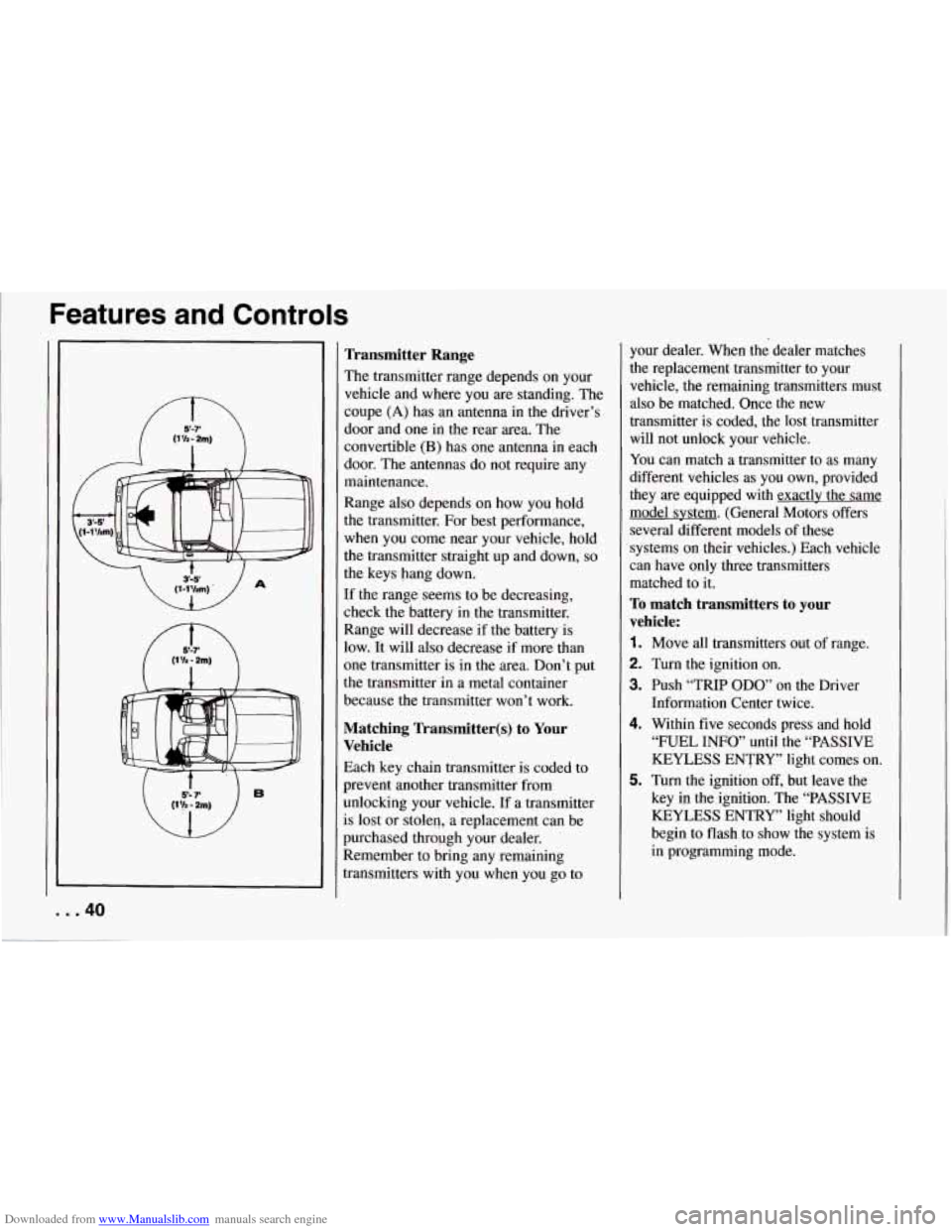
Downloaded from www.Manualslib.com manuals search engine Features and Controls
I T
Transmitter Range
The transmitter range depends on your
vehicle and where you are standing. The
coupe
(A) has an antenna in the driver’s
door and one in the rear area. The
convertible
(B) has one antenna in each
door. The antennas do not require any
maintenance.
Range also depends on how you hold
the transmitter. For best performance,
when you come near your vehicle, hold
the transmitter straight up and down,
so
the keys hang down.
If the range seems to be decreasing,
check the battery
in the transmitter.
Range will decrease if the battery is
low. It will also decrease if more than
one transmitter is in the area. Don’t put
the transmitter in a metal container
because the transmitter won’t work.
Matching Transmitter(s) to Your
Vehicle
Each key chain transmitter is coded to
prevent another transmitter from
unlocking your vehicle. If a transmitter
is lost or stolen, a replacement can be
?urchased through your dealer.
Remember to bring any remaining
:ransmitters with you when you go to your dealer. When the dealer matches
the replacement transmitter
to your
vehicle, the remaining transmitters must
also be matched. Once the new
transmitter is coded, the lost transmitter
will not unlock your vehicle.
You can match a transmitter to as many
different vehicles as you own, provided
they are equipped with exactly the same
model -system. (General Motors offers
several different models of these
systems on their vehicles.) Each vehicle
can have only three transmitters
matched to it.
To match transmitters to your
vehicle:
1. Move all transmitters out of range.
2. Turn the ignition on.
3. Push “TRIP ODO’ on the Driver
Information Center twice.
4. Within five seconds press and hold
“FUEL INFO’ until the “PASSIVE
KEYLESS ENTRY” light comes on.
5. Turn the ignition off, but leave the
key in the ignition. The “PASSIVE
KEYLESS ENTRY” light should
begin to flash to show the system is
in programming mode.
Page 42 of 274
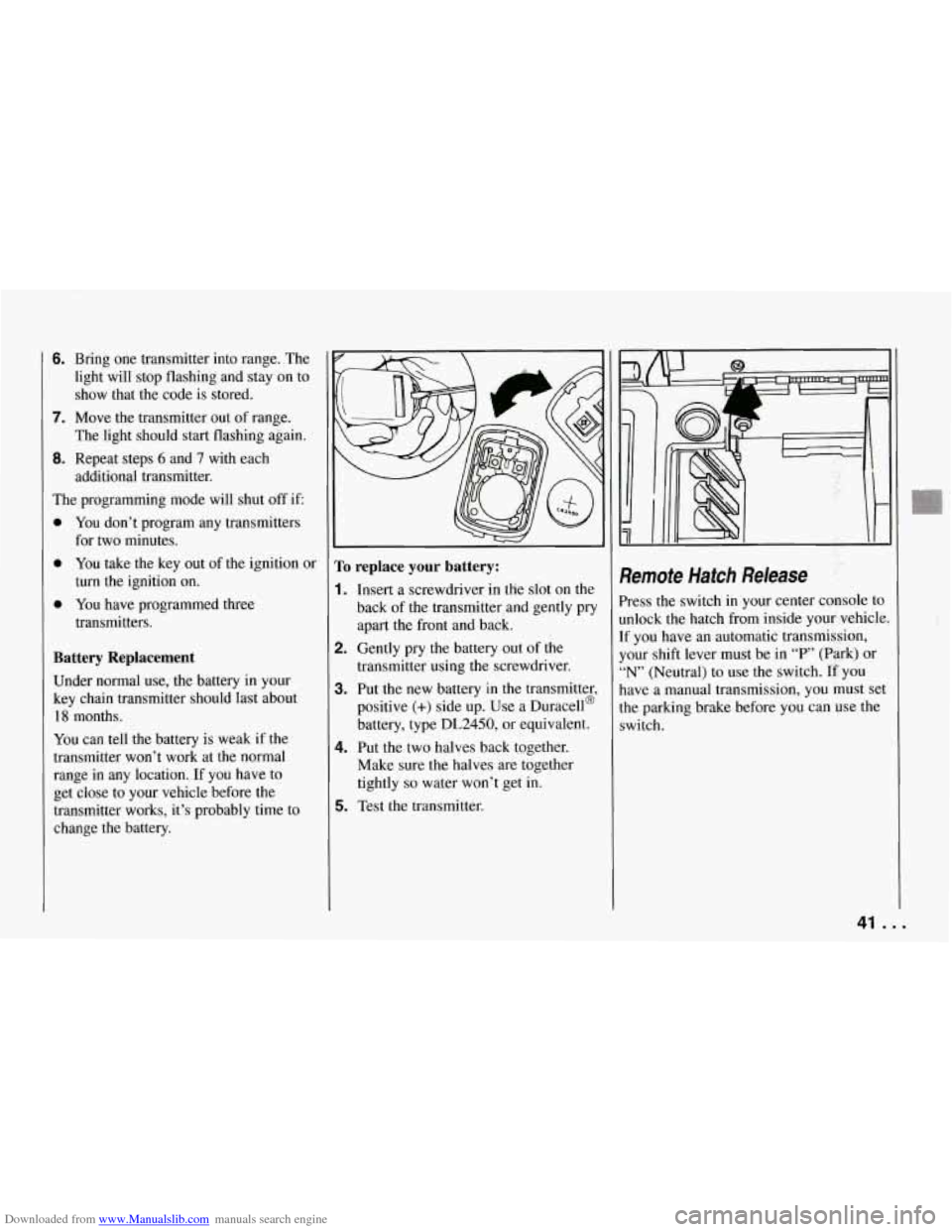
Downloaded from www.Manualslib.com manuals search engine 6. Bring one transmitter into range. The
light will stop flashing and stay on to
show that the code is stored.
7. Move the transmitter out of range.
8. Repeat steps 6 and 7 with each
The programming mode will shut
off if:
0 You don’t program any transmitters
0 You take the key out of the ignition or
0 You have programmed three
The light should
start flashing again.
additional transmitter.
for two minutes.
turn the ignition on.
transmitters.
Battery Replacement
Under normal use, the battery in your
key chain transmitter should last about
18 months.
You can tell the battery is weak if the
transmitter won’t work at
the normal
range in any location.
If you have to
get close to your vehicle before the
transmitter works, it’s probably time to
change the battery.
ro replace your battery:
I. Insert a screwdriver in the slot on the
back
of the transmitter and gently pry
apart the front and back.
2. Gently pry the battery out of the
transmitter using the screwdriver.
3. Put the new battery in the transmitter,
positive
(+) side up. Use a Duracell@
battery, type DL2450, or equivalent.
4. Put the two halves back together.
Make sure the halves are together
tightly
so water won’t get in.
5. Test the transmitter.
?emote Hatch Release
’ress the switch in your center console to
mlock the hatch from inside your vehicle
f you have an automatic transmission,
[our shift lever must be
in “P’ (Park) or
‘N’ (Neutral) to use the switch. If you
lave a manual transmission, you must sei
he parking brake before you can use the
;witch.
..
.i ,
41 ...
Page 43 of 274
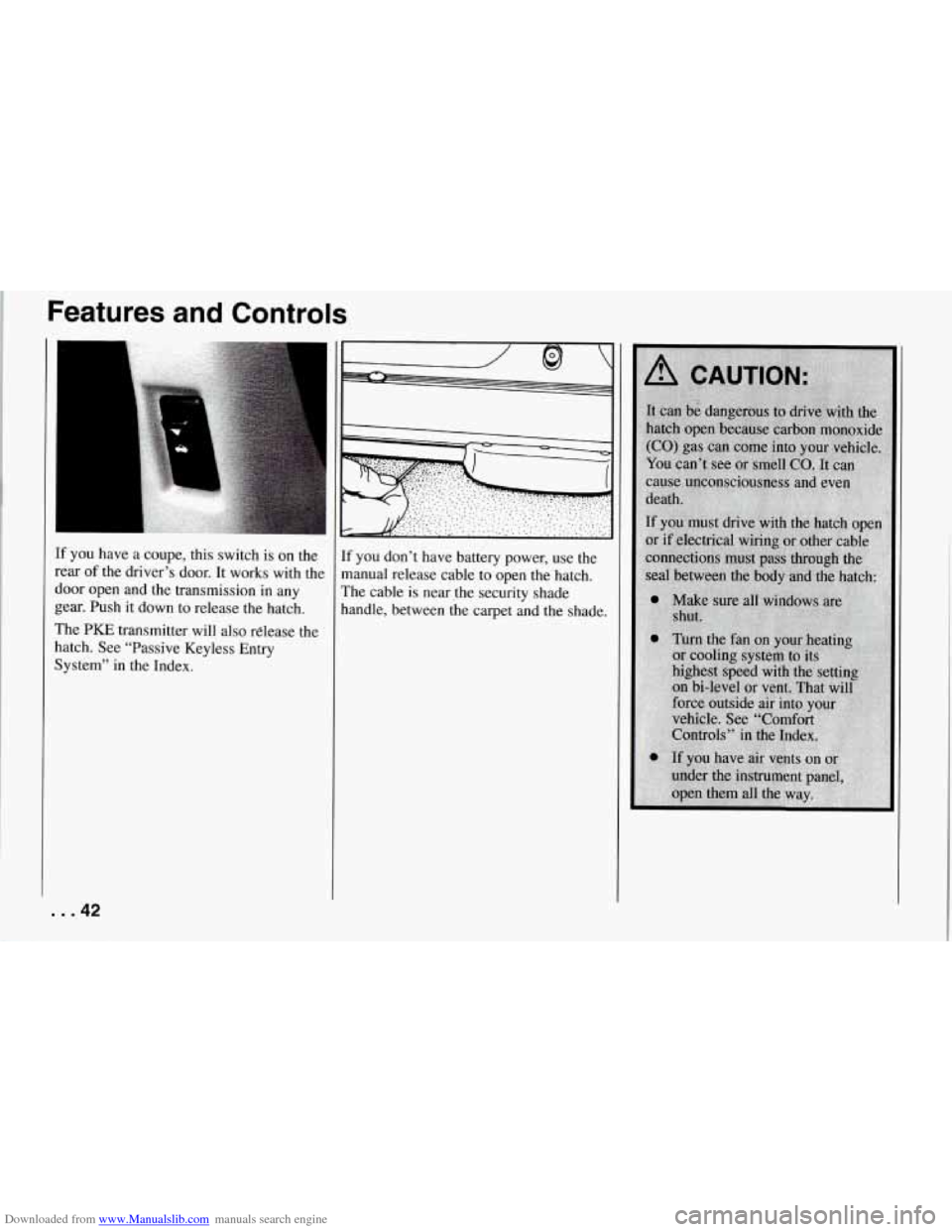
Downloaded from www.Manualslib.com manuals search engine Features and Controls
If you have a coupe, this switch is on the
rear of the driver’s door. It works with the
door open and the transmission in any
gear. Push it down to release the hatch.
The PKE transmitter will also release the
hatch. See “Passive Keyless Entry
System” in the Index.
... 42
If you don’t have battery power, use the
manual release cable
to open the-hatch.
The cable is near the security shade
handle, between the carpet and the shade.
Page 44 of 274
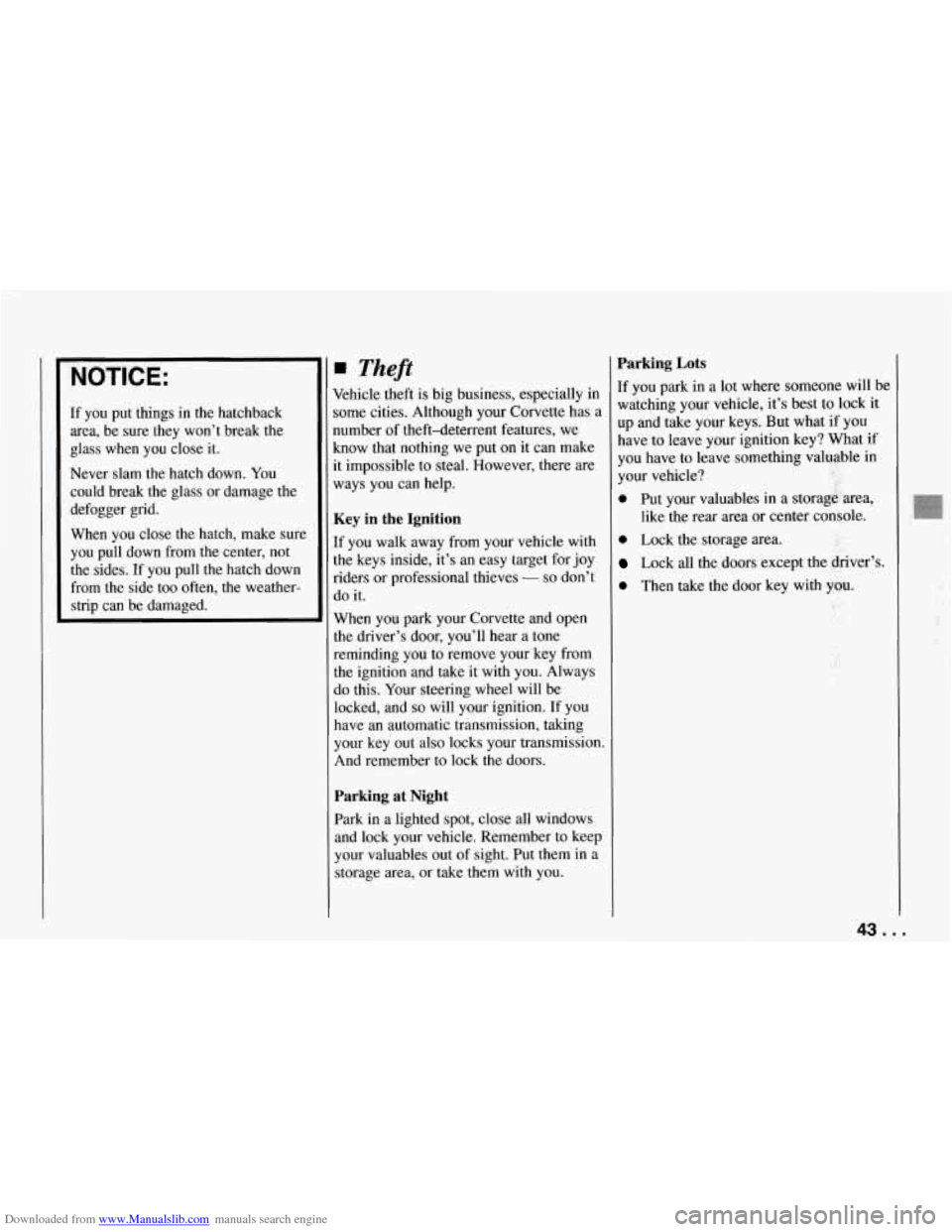
Downloaded from www.Manualslib.com manuals search engine NOTICE:
If you put things in the hatchback
area, be sure they won’t break the
glass when
you close it.
Never slam the hatch down. You
could break the glass or damage the
defogger grid.
When you close the hatch, make sure
you pull down from the center, not
the sides. If you pull the hatch down
1 from the side too often, the weather-
1 strip can be damaged.
Theft
Vehicle theft is big business, especially in
;ome cities. Although your Corvette has a
lumber of theft-deterrent features, we
mow that nothing we put on
it can make
It impossible to steal. However, there are
ways you can help.
Key in the Ignition
[f you walk away from your vehicle with
the keys inside, it’s an easy target for joy
riders or professional thieves
- so don’t
do it.
When you park your Corvette and open
the driver’s door, you’ll hear a tone
reminding you to remove your key from
the ignition and take it with you. Always
do this. Your steering wheel will be
locked, and
so will your ignition. If you
have an automatic transmission, taking
your key out also locks your transmission.
And remember to lock the doors.
Parking at Night
Park in a lighted spot, close all windows
and lock your vehicle. Remember to keep
your valuables out of sight. Put them in a
storage area, or take them with you.
Parking Lots
If you park in a lot where someone will be
watching your vehicle, it’s best to lock it
up and take your keys. But what if you
have to leave your ignition key? What
if
you have to leave something valuable in
your vehicle?
0 Put your valuables in a storage area,
0 Lock the storage area.
Lock all the doors except the driver’s.
0 Then take the door key with you.
like the rear area or center console.
43 ...
Page 45 of 274
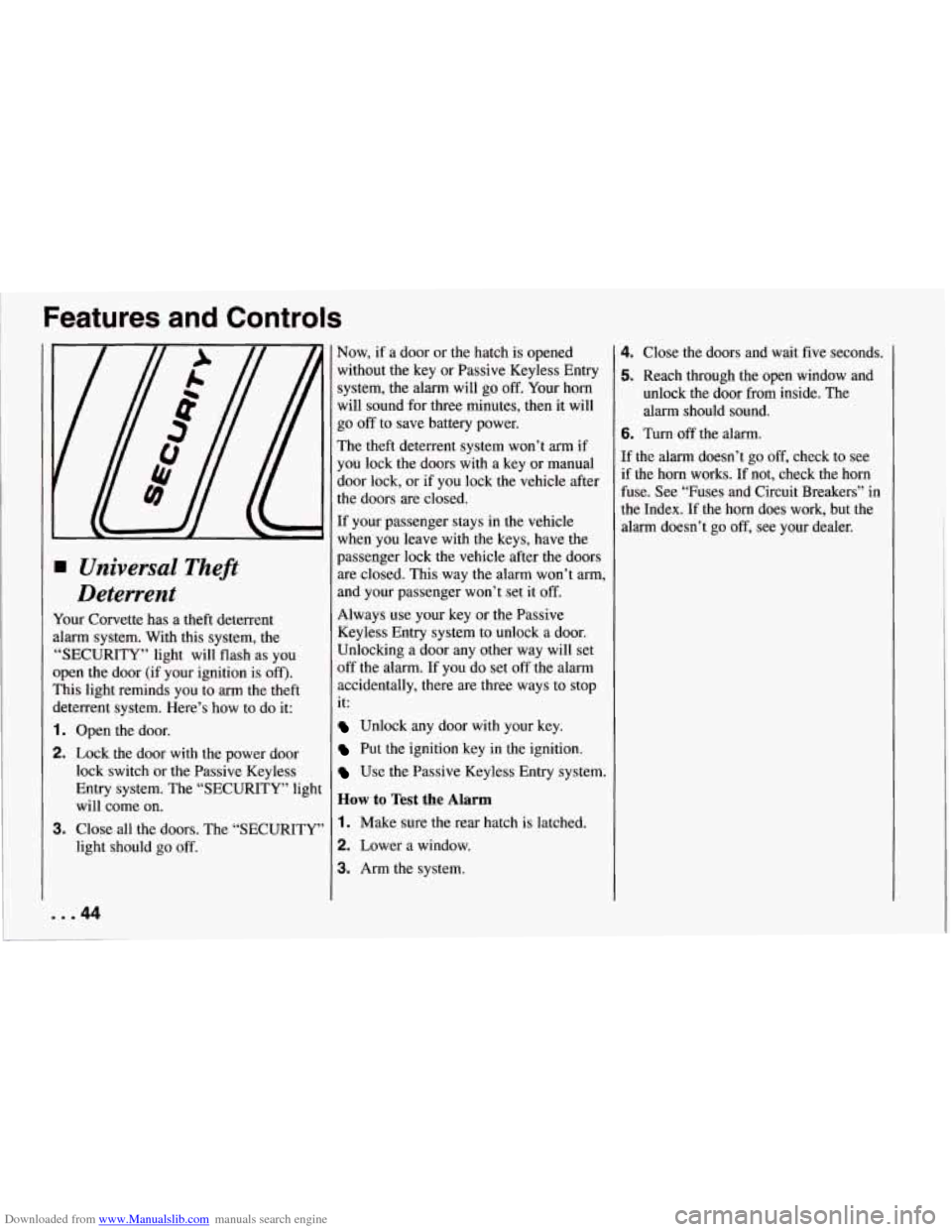
Downloaded from www.Manualslib.com manuals search engine Features and Controls
I Universal Theft
Deterrent
‘our Corvette has a theft deterrent
larm system. With this system, the
SECURITY” light will flash as you
pen the door (if your ignition is
off).
‘his light reminds you to arm the theft
eterrent system. Here’s how to do it:
. Open the door.
. Lock the door with the power door
lock switch or the Passive Keyless
Entry system. The “SECURITY” lieht
will come on.
. Close all the doors. The “SECURITY’
light should go
off.
... 44
Now, if a door or the hatch is opened
without the key or Passive Keyless Entry
system, the alarm will go
off. Your horn
will sound for three minutes, then it will
go
off to save battery power.
The theft deterrent system won’t
arm if
you lock the doors with a key or manual
door lock, or if you lock the vehicle after
the doors are closed.
If your passenger stays in the vehicle
when you leave with the keys, have the
passenger lock the vehicle after the doors
are closed. This way the alarm won’t
arm,
and your passenger won’t set it off.
Always use your key or the Passive
Keyless Entry system to unlock a door.
Unlocking a door any other way will set
off the alarm.
If you do set off the alarm
accidentally, there are three ways to stop
it:
Unlock any door with your key.
Put the ignition key in the ignition.
Use the Passive Keyless Entry system.
How to Test the Alarm
1. Make sure the rear hatch is latched.
2. Lower a window.
3. Arm the system.
4. Close the doors and wait five seconds.
5. Reach through the open window and
unlock the door from inside. The
alarm should sound.
6. Turn off the alarm.
If the alarm doesn’t go
off, check to see
if the horn works. If not, check the horn
fuse. See “Fuses and Circuit Breakers” in
the Index. If the horn does work, but the
alarm doesn’t go
off, see your dealer.
Page 46 of 274
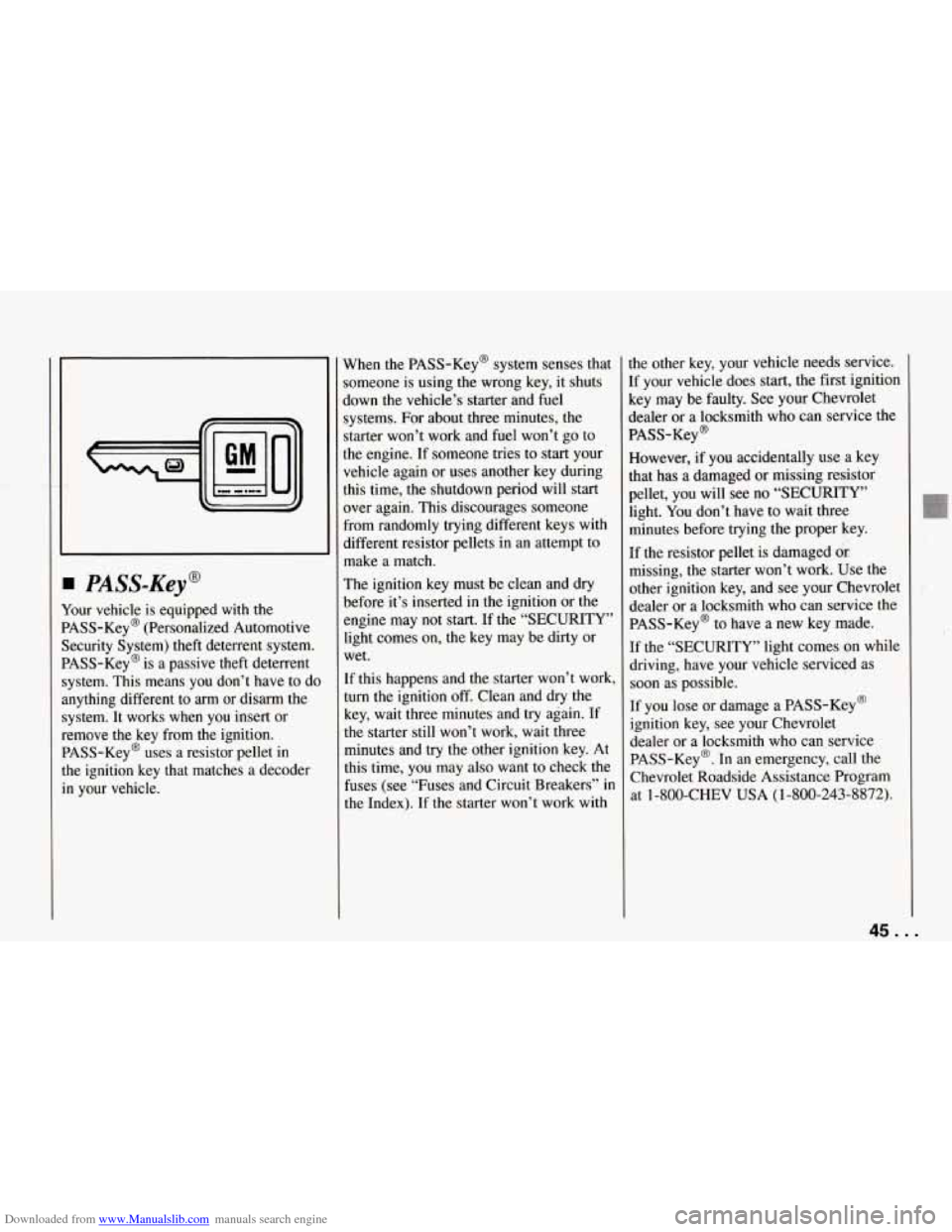
Downloaded from www.Manualslib.com manuals search engine I
PASS-Key@
Your vehicle is equipped with the
PASS-Key@ (Personalized Automotive
Security System) theft deterrent system.
PASS-Key@ is a passive theft deterrent
system. This means you don’t have to do
anything different to arm or disarm the
system. It works when you insert or
remove the key from the ignition.
PASS-Key@ uses a resistor pellet in
the ignition key that matches a decoder
in your vehicle. When the PASS-Key@ system
senses that
someone is using the wrong key, it shuts
down the vehicle’s starter and fuel
systems. For about three minutes,
the
starter won’t work and fuel won’t go to
the engine. If someone tries to start your
vehicle again or uses another key during
this time, the shutdown period will start
over again. This discourages someone
from randomly trying different keys with
different resistor pellets in an attempt to
make a match.
The ignition key must be clean and dry
before it’s inserted in
the ignition or the
engine may not start. If the “SECURITY”
light comes on, the key may be dirty or
wet.
If this happens and the starter won’t work,
turn the ignition off. Clean and dry
the
key, wait three minutes and try again. If
the starter still won’t work, wait three
minutes and
try the other ignition key. At
this time, you may also want to check
the
fuses (see “Fuses and Circuit Breakers’’ in
the Index). If the starter won’t work with the
other key, your vehicle needs service.
[f your vehicle does start, the first ignition
key may be faulty. See your Chevrolet
Jealer or a locksmith who can service the
PASS-Key@
However, if you accidentally use a key
that has
a damaged or missing resistor
pellet, you will see no “SECURITY”
light.
You don’t have to wait three
minutes before trying the proper key.
if the resistor pellet is damaged
OF
missing, the starter won’t work. Use the
other ignition key, and see your Chevrolet
dealer or a locksmith who can service the
PASS-Key@ to have a new key made.
If the “SECURITY” light comes on while
driving, have your vehicle serviced as
soon as possible.
If you lose or damage a PASS-Key@
ignition key, see your Chevrolet
dealer or a locksmith who can service
PASS-Key@. In an emergency, call the
Chevrolet Roadside Assistance Program
at
1 -800-CHEV USA (1 -800-243-8872).
45 . I
Page 47 of 274
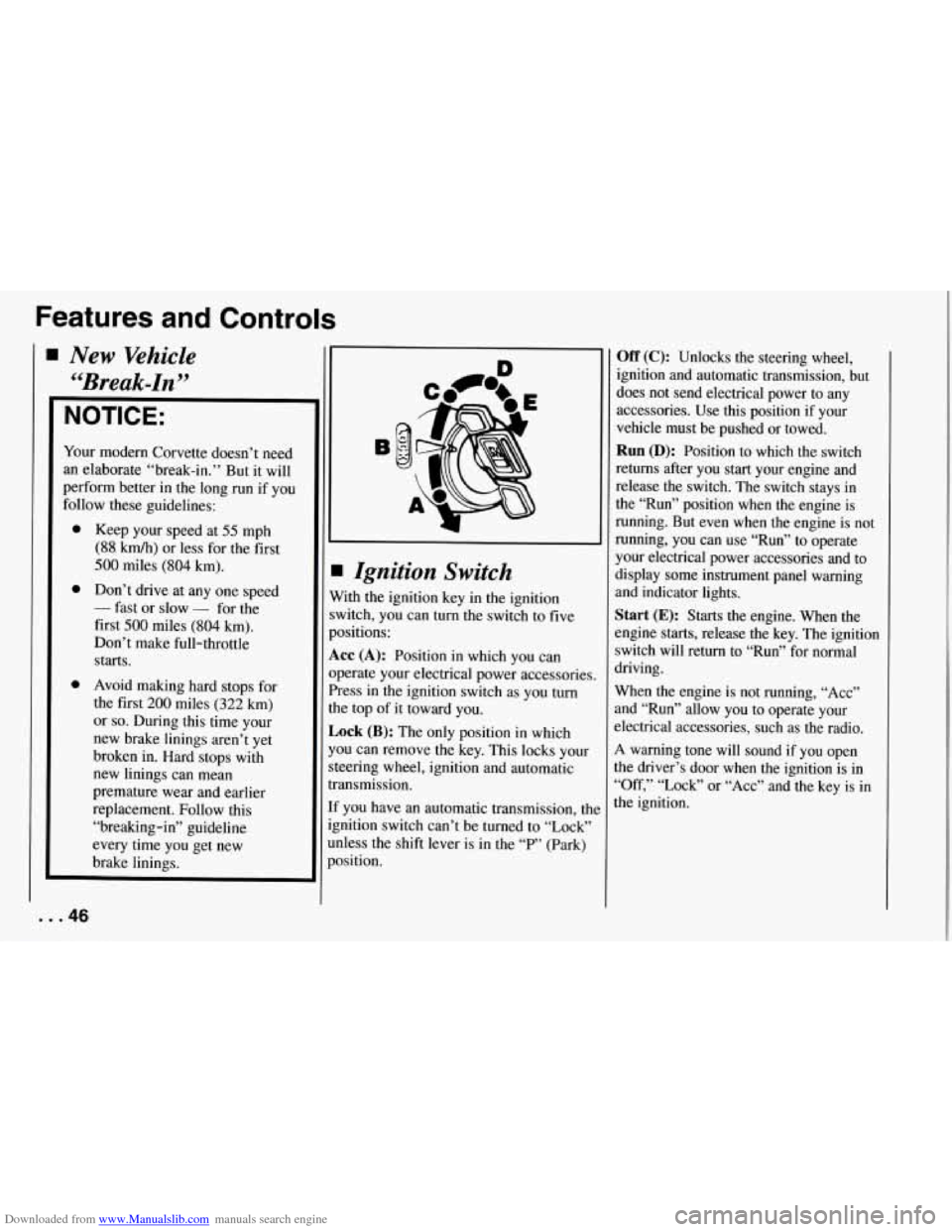
Downloaded from www.Manualslib.com manuals search engine Features and Controls
NOTICE:
Your modern Corvette doesn’t need
an elaborate “break-in.” But it will
perform better in the long run if you
follow these guidelines:
0 Keep your speed at 55 mph
(88 km/h) or less for the first
500 miles (804 km).
Don’t drive at any one speed
- fast or slow - for the
fist
500 miles (804 km).
Don’t make full-throttle
starts.
Avoid malung hard stops for
the first
200 miles (322 km)
or so. During this time your
new brake linings
aren’t yet
broken in.
Hard stops with
new linings can mean
premature wear and earlier
replacement. Follow this
“breaking-in” guideline
every time you get new
brake linings.
I
Ignition Switch
With the ignition key in the ignition
switch, you can turn the switch to five
positions:
Acc (A): Position in which you can
operate your electrical power accessories.
Press in the ignition switch as you turn
the top of it toward you.
Lock (B): The only position in which
you can remove the key. This locks your
steering wheel, ignition and automatic
transmission.
If you have an automatic transmission, tht
ignition switch can’t be turned to “Lock”
unless the shift lever
is in the “P” (Park)
position.
... 46
Off (C): Unlocks the steering wheel,
ignition and automatic transmission, but
does not send electrical power to any
accessories. Use
this position if your
vehicle must be pushed
or towed.
Run (D): Position to which the switch
returns after you start your engine and
release the switch. The switch stays in
the “Run” position when the engine is
running. But even when the engine is not
running, you can use “Run” to operate
your electrical power accessories and to
display some instrument panel warning
and indicator lights.
Start (E): Starts the engine. When the
engine
starts, release the key. The ignition
switch will return to “Run” for normal
driving.
When the engine is not running, “Acc”
and “Run” allow you to operate your
slectrical accessories, such as the radio.
A warning tone will sound if you open
the driver’s door when the ignition is in
“Off,’’ “Lock” or “Acc” and the key is in
the ignition.
Page 48 of 274
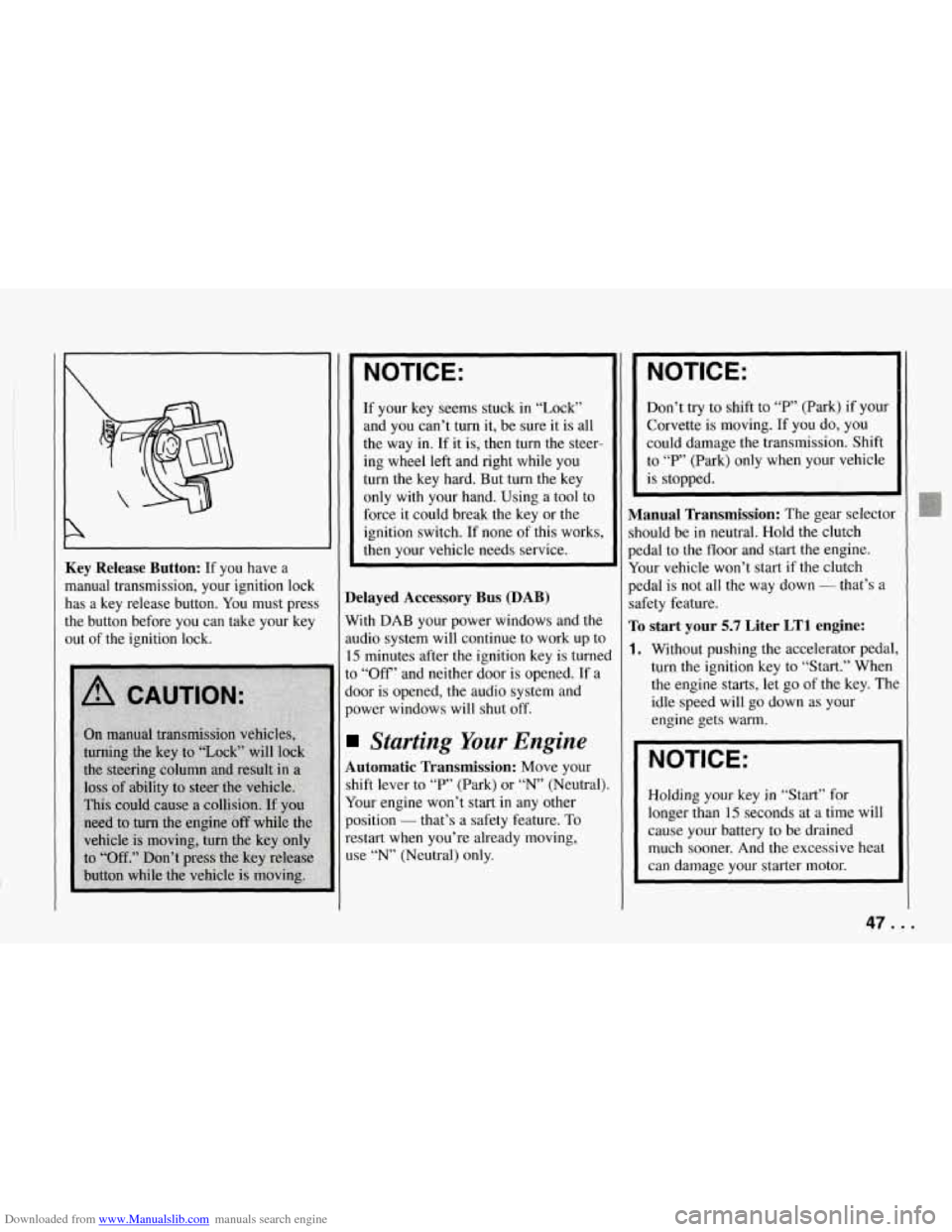
Downloaded from www.Manualslib.com manuals search engine Ke
ma
ha! the
ou1
!y Release Button: If you have a
lnual transmission, your ignition lock
; a key release button. You must press
: button before you can take your key
t of the ignition lock.
NOTICE:
If your key seems stuck in “Lock”
and you can’t turn it, be sure it is all
the way in. If it is, then turn the steer-
ing wheel left and right while you
turn the key hard. But turn the key
only with your hand. Using a tool to
force it could break the key or the
ignition switch. If none of this works,
then your vehicle needs service.
Delayed Accessory Bus (DAB)
With DAB your power windows and the
audio system will continue to work up to
15 minutes after the ignition key is turnec
to “Off’ and neither door is opened.
If a
door is opened, the audio system and
power windows will shut
off.
Starting Your Engine
Automatic Transmission: Move your
shift lever to
“P’ (Park) or “N” (Neutral).
Your engine won’t start in any other
position
- that’s a safety feature. To
restart when you’re already moving,
use
“N” (Neutral) only.
NOTICE:
Don’t try to shift to “P” (Park) if your
Corvette is moving. If you do, you
could damage the transmission. Shift
to
“P” (Park) only when your vehicle
is stopped.
ManuaI Transmission: The gear selector
should be
in neutral. Hold the clutch
pedal to the
floor and start the engine.
Your vehicle won’t start if the clutch
pedal is not all the way down
- that’s a
safety feature.
To start your 5.7 Liter LTl engine:
1. Without pushing the accelerator pedal
turn the ignition key to “Start.” When
the engine starts, let go of the key. Thl
idle speed will go down as your
engine gets warm.
NOTICE:
Holding your key in “Start” for
longer than 15 seconds at a time will
cause your battery to be drained
much sooner. And the excessive heat
can damage your starter motor.
47 ...
Page 49 of 274
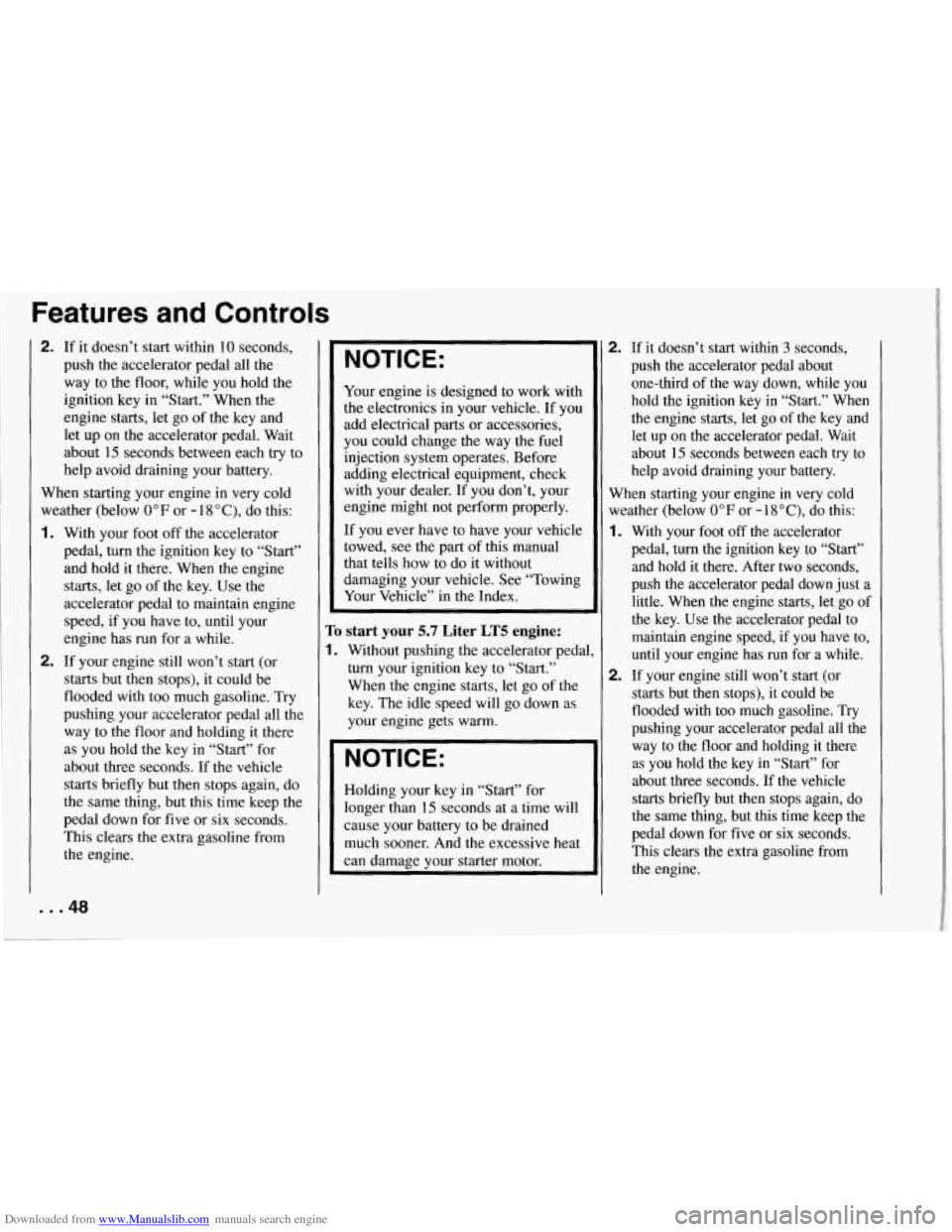
Downloaded from www.Manualslib.com manuals search engine Features and Controls
2. If it doesn’t start within 10 seconds,
push the accelerator pedal all the
way to the floor, while you hold the
ignition key in “Start.” When the
engine starts, let go of the key and
let up on the accelerator pedal. Wait
about
15 seconds between each try to
help avoid draining your battery.
When starting your engine in very cold
weather (below
0°F or - 18 “C), do this:
1.
2.
With your foot off the accelerator
pedal, turn the ignition key to “Start”
and hold it there. When the engine
starts, let go of the key. Use the
accelerator pedal to maintain engine
speed, if you have to, until your
engine has run for a while.
If your engine still won’t start (or
starts but then stops), it could be
flooded with too much gasoline. Try
pushing your accelerator pedal all the
way to
the floor and holding it there
as you hold the key in “Start” for
about three seconds. If
the vehicle
starts briefly but then stops again, do
the same thing, but this time keep the
pedal down for five or six seconds.
This clears the extra gasoline from
the engine.
NOTICE:
Your engine is designed to work with
the electronics in your vehicle. If you
add electrical parts or accessories,
you could chimge the way the fuel
injection system operates. Before
adding electrical equipment, check
with your dealer. If you don’t, your
engine might not perform properly.
If you ever have to have your vehicle
towed, see
the part of this manual
that tells how to do it without
damaging your vehicle. See “Towing
Your Vehicle”
in the Index.
Ib start your 5.7 Liter LT5 engine:
1. Without pushing the accelerator pedal
turn your ignition key to “Start.”
When the engine starts, let go of
the
key. The idle speed will go down as
your engine gets warm.
NOTICE:
Holding your key in “Start” for
longer than
15 seconds at a time will
cause your battery to be drained
much sooner. And the excessive heat
can damage your starter motor.
2. If it doesn’t start within 3 seconds,
push the accelerator pedal about one-third of the way down, while you
hold the ignition key
in “Start.” When
the engine starts, let go of the key and
let up on the accelerator pedal. Wait
about
15 seconds between each try to
help avoid draining your battery.
When starting your engine in very cold weather (below
0°F or -18”C), do this:
1.
2.
With your foot off the accelerator
pedal,
turn the ignition key to “Start”
and hold it there. After two seconds,
push the accelerator pedal down just a
little. When the engine starts, let go of
the key. Use the accelerator pedal to
maintain engine speed, if you have to,
until your engine has
run for a while.
If your engine still won’t start (or
starts but then stops), it could be
flooded with too much gasoline. Try
pushing your accelerator pedal all the way to the floor and holding it there
as you hold the key in “Start” for
about three seconds. If the vehicle
starts briefly but then stops again, do
the same thing, but this time keep
the
pedal down for five or six seconds.
This clears the extra gasoline from
the engine.
... 48
Page 50 of 274
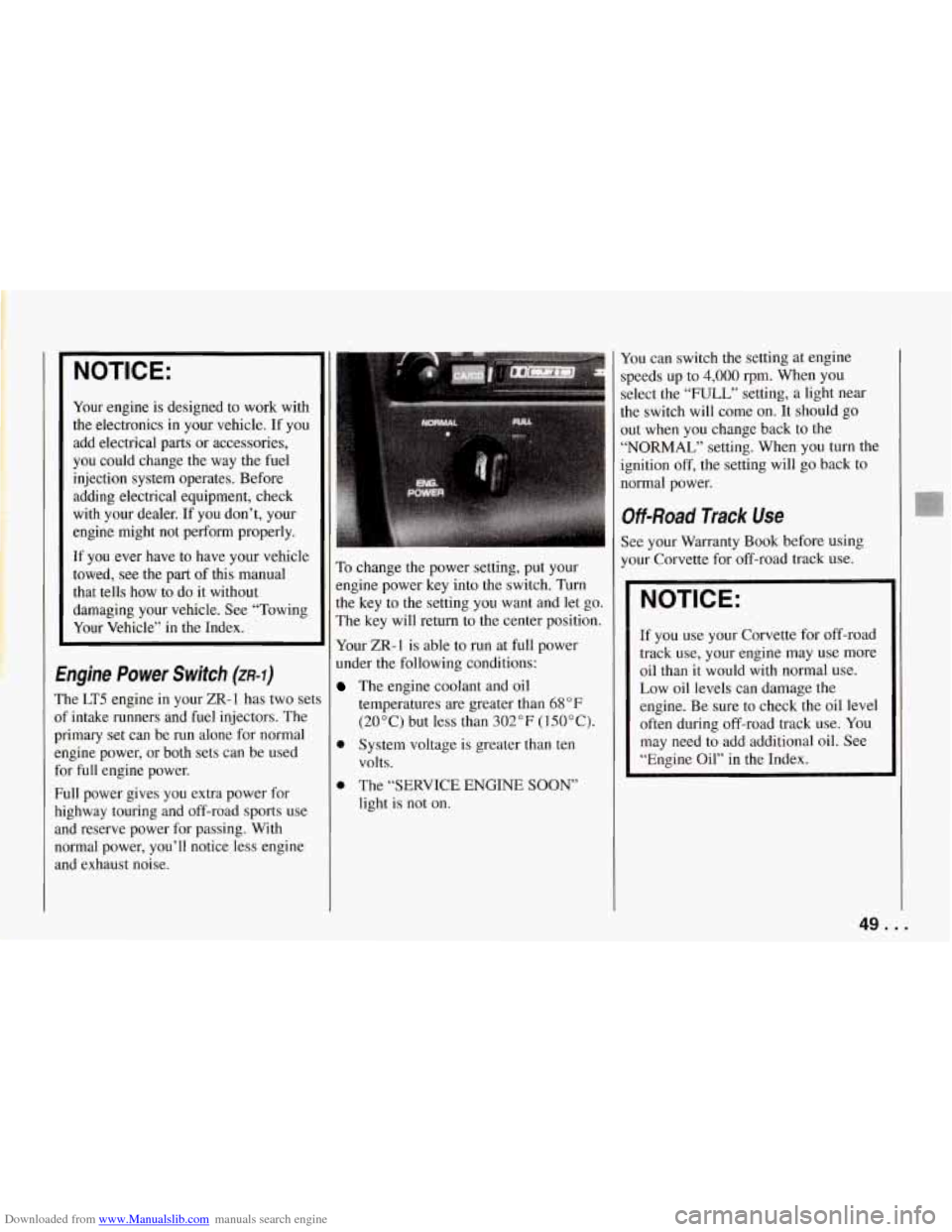
Downloaded from www.Manualslib.com manuals search engine I NOTICE:
Your engine is designed to work with
the electronics in your vehicle. If you
add electrical parts or accessories,
you could change the way the fuel
injection system operates. Before
adding electrical equipment, check
with your dealer. If you don’t, your
engine might not perform properly.
If you ever have to have your vehicle
towed, see the part
of this manual
that tells how to do it without
damaging your vehicle. See “Towing
Your Vehicle” in the Index.
Engine Power Switch (ZR-I)
The LT5 engine in your ZR-1 has two sets
of intake runners and fuel injectors. The
primary set can be run alone for normal
engine power, or both sets can be used
for
full engine power.
Full power gives you extra power for
highway touring and off-road sports use
and reserve power for passing. With
normal power, you’ll notice less engine
and exhaust noise. To
change the power setting, put your
engine power key into the switch. Turn
the key to the setting you want and let
go
The key will return to the center position.
Your ZR-1 is able to run at full power
under the following conditions:
The engine coolant and oil
temperatures are greater than
68 OF
(20°C) but less than 302°F (150°C).
e System voltage is greater than ten
e The “SERVICE ENGINE SOON’
volts.
light is not on.
You can switch the setting at engine
speeds up to
4,000 rpm. When you
select the
“FULL” setting, a light near
[he switch will come on. It should go
>ut when you change back to the
“NORMAL” setting. When you turn the
ignition
off, the setting will go back to
normal power.
Off-Road Track Use
See your Warranty Book before using
your Corvette for off-road track use.
NOTICE:
If you use your Corvette for off-road
track use, your engine may use more
oil than it would with normal use.
Low oil levels can damage the
engine. Be sure to check the oil level
often during off-road track use.
You
may need to add additional oil. See
“Engine Oil” in the Index.
49 ...